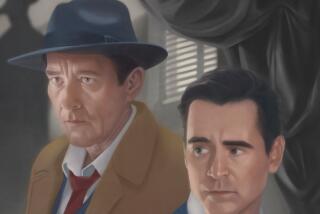Everywhere a bleak outlook
- Share via
JULES DASSIN was one of the key filmmakers of postwar America. In the late 1940s, having escaped the restrictive employment of MGM, he reinvented himself as a director of brash, socially conscious pulp. By 1950, he was on the blacklist, and the Hollywood career of this committed leftist, the Connecticut-born son of a Russian Jewish immigrant, was effectively over. Dassin moved to Paris, where after a period of unemployment, he made “Rififi” (1954), one of the most influential heist movies of all time. Now 95, he lives in Athens, home of his late wife (and star of his 1960 hit “Never on Sunday”), Melina Mercouri.
The Criterion Collection has given its usual fastidious attention to the remarkable run of movies Dassin made before he went into exile. “Thieves’ Highway” (1949) and “Night and the City” (1950) were released in sumptuous, extras-packed editions a couple of years ago. A second pair of DVDs -- “Brute Force” (1947), out Tuesday, and “The Naked City” (1948), released last month -- completes the set. Dassin is known as a noir stylist, and his best films demonstrate not only his diversity as a filmmaker but also the broad range of genres that fell under the rubric of noir: “Brute Force” is a prison-break movie and “The Naked City” a police procedural.
In “Brute Force,” Burt Lancaster leads a band of downtrodden inmates in a planned escape from a penitentiary that the film blatantly equates to a fascist state. A few scenes draw from the raw imagery of concentration camps, and the villain takes the crypto-Nazi form of Hume Cronyn’s Capt. Munsey, an effete sadist who tortures prisoners while listening to Wagner.
Bristling with anarchic energy, the movie, produced by Mark Hellinger and shot by William Daniels, throws in its lot with the oppressed proletariat -- i.e., the prisoners -- as they struggle to break free of a tyrannical institution. While Cronyn’s power-mad sociopath plots to depose the spineless warden, it’s left to the resident doctor (Art Smith), the only sympathetic authority figure and an inveterate drunk, to articulate the film’s message -- that brute force breeds more of the same. Indeed, the prisoners are hardly doormats -- in an unnerving display of vigilante brutality, a few of them surround a stool pigeon with blowtorches and hound him to his death under a steam press.
Given the film’s glancing debts to Soviet political iconography, the prisoners could easily have been left as abstractions. Instead, awkward flashbacks are assigned to Lancaster and his cellmates. These scenes, which Dassin blamed on his producers, link the “men on the inside” with their “women on the outside” (as the credits put it). It’s a suspect bit of deck stacking, intended to establish the men’s basic decency, and it also upsets the intimacy and momentum of the movie. There’s nothing timid about the finale, though -- a mad lunge for freedom that unites the urgency of revolutionary propaganda with the fatalism of noir.
You could think of “The Naked City,” an early triumph of location cinematography, as the venerable granddaddy of the “Law and Order” franchise. The title comes from the first collection by tabloid photographer Weegee; producer Hellinger, a former newspaper columnist, supplies the omniscient narration that contains the immortal phrase “8 million stories in the naked city.”
The central murder investigation is routine, but as Hellinger’s narration and Daniels’ spectacular cinematography make clear, the living, breathing city is very much the main character. In an era of backlot artifice, “The Naked City” featured an astonishing 107 locations (Daniels won an Oscar for his efforts). It captures a lost Manhattan of elevated trains and horse-drawn carriages and even ventures into the mortuary of Bellevue Hospital and across the East River into the outer boroughs. Daniels’ camera squeezes into rush-hour subways and tenement stairwells, and in a thrilling final chase, through the crowded streets of the Lower East Side and up the towers of the Williamsburg Bridge.
More to Read
Only good movies
Get the Indie Focus newsletter, Mark Olsen's weekly guide to the world of cinema.
You may occasionally receive promotional content from the Los Angeles Times.










